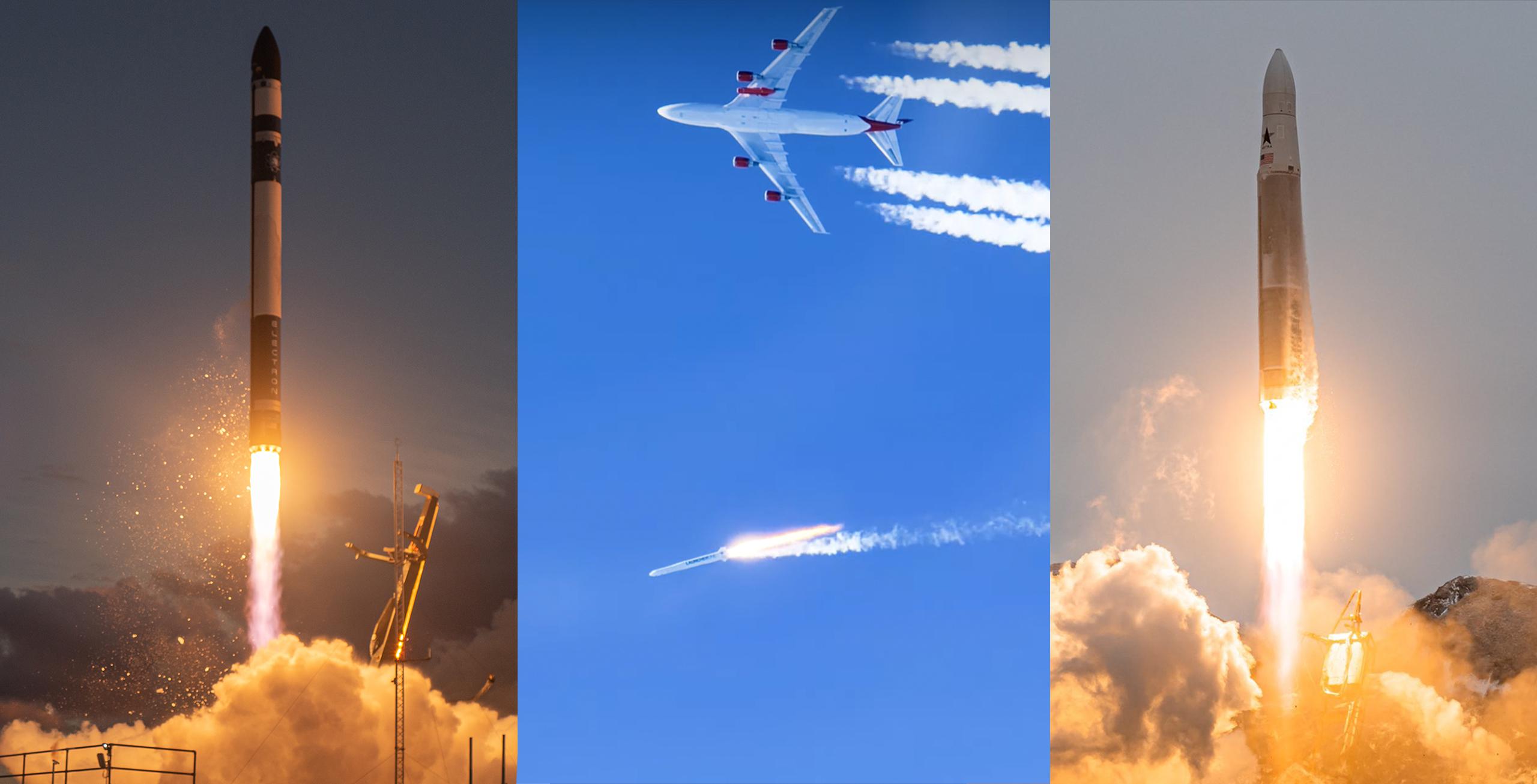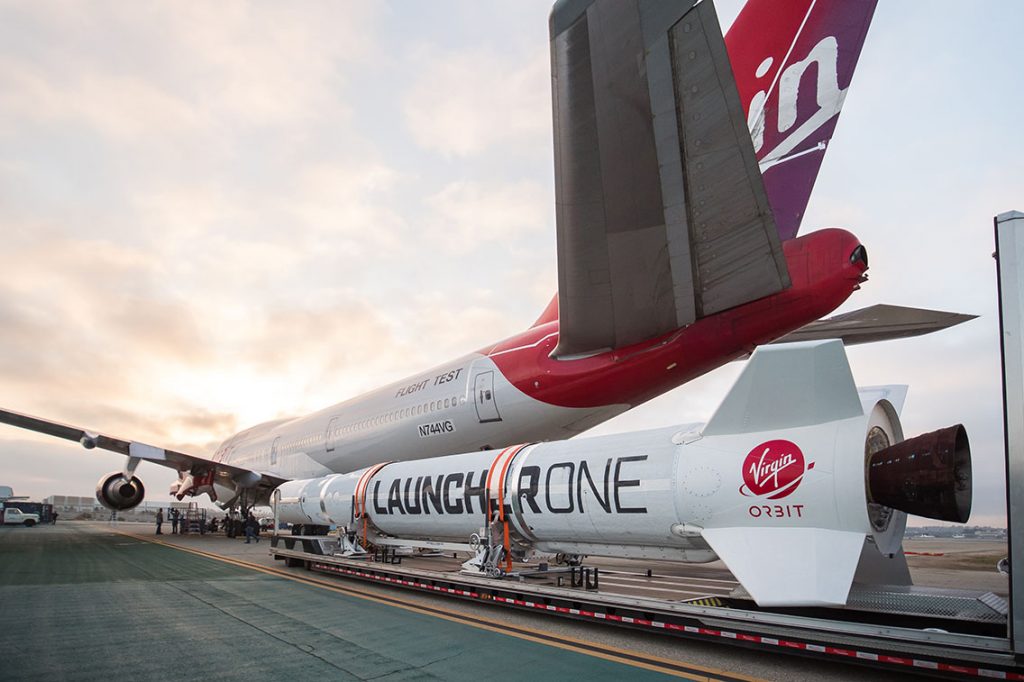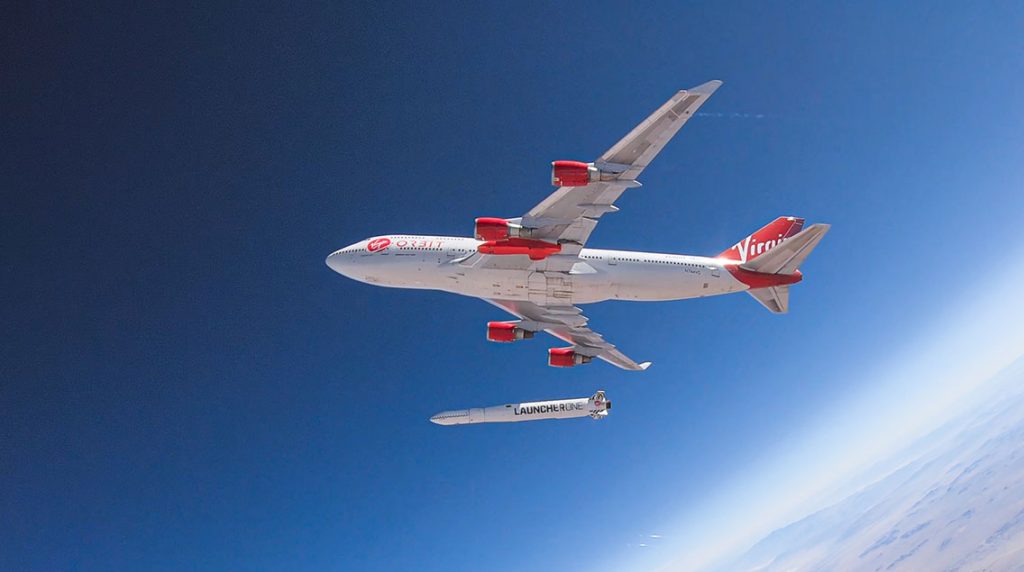

News
Rocket Lab, Virgin Orbit lead a new class of small rockets with big ambitions for 2021
SpaceX’s reign as the only privately funded American spaceflight company to reach and successfully deploy small satellite payloads into orbit ended on January 21, 2018, when Rocket Lab’s Electron rocket delivered three customer CubeSats to orbit for the first time.
SpaceX and Rocket Lab have since been the only private American companies to offer dedicated and rideshare delivery of small satellites to orbit. That is until Virgin Orbit joined the competition with the success of its Launch Demo 2 mission earlier this week.
Airdropping rockets
On Sunday, January 17, Virgin Orbit – one of two spaceflight companies backed by billionaire Richard Branson – joined SpaceX and Rocket Lab as the next private American rocket launcher sending small satellites to space. Virgin Orbit delivers its payload slightly differently than SpaceX and Rocket Lab. Virgin Orbit can uniquely offer its customers the flexibility of launch site because its liquid-fueled rocket is dropped mid-air from under the wing of a massive Boeing 747 before propelling itself to space.
In the Spring of 2020 Virgin Orbit conducted its first Launch Demo mission off of the coast of southern California. Prior to the rocket’s first stage ignition, the company achieved the majority of its intended test flight targets. Just after LauncherOne’s first stage ignition the rocket prematurely shut down resulting in the complete loss of the rocket and its payload as it fell to the ocean.

After months of investigation, Virgin Orbit attributed the prematurely terminated flight to a component failure that led to a breach of a high-pressure line starving the engine of Liquid Oxygen resulting in the immediate loss of propulsion. The issue was remedied quickly and Virgin Orbit aimed to fly and launch again in December 2020 for its Launch Demo 2 mission attempting to successfully achieve orbit by the close of the year. In mid-December, the launch date of Launch Demo 2 was postponed until January 2021 due to impacts to operation and scheduling caused by the Covid-19 pandemic.
Virgin Orbit’s 747, Cosmic Girl, piloted by Kelly Latimer took to the skies on Sunday, January 17 with a fully fueled LauncherOne rocket loaded with a payload of nine CubeSat missions made up of ten spacecraft for NASA’s Educational Launch of NanoSatellites (ELaNa XX) series contracted under NASA’s Venture Class Launch Services program.

The Launch Demo 2 mission went off without a hitch. Just as with the first Launch Demo, all pre-launch activities proceeded nominally with Cosmic Girl reaching an altitude of 30,000 feet prior to the release of LauncherOne over the Pacific Ocean. Once released into free flight, the rocket’s first stage engine ignited and carried it through the atmosphere until separation and second stage engine ignition beyond the Kármán line – the recognized point at which “space” is defined beyond Earth’s atmosphere. Eventually, all nine payloads were successfully deployed into orbit completing the first-ever successful mission of an orbital class, liquid-fueled, air-launched rocket to reach space.
Another One Leaves The Crust
SpaceX has set the pace for space in 2021 successfully achieving two orbital-class launches within the first twenty days of the year with a third mission scheduled to depart Launch Complex 40 at Cape Canaveral Space Force Base in Florida on Friday, January 22. Likewise, Rocket Lab looks to aggressively exceed its previous launch record of seven missions in one calendar year. The only way to demolish a previous record is to launch frequently from multiple spaceports. SpaceX currently has three active launchpads, two in Florida and one in California. Within 2021, Rocket Lab will also have three operational launchpads, two in New Zealand and one in Virginia.
On Wednesday, January 20, 2021 – its third anniversary of first making it to orbit – Rocket Lab successfully launched its first Electron mission of 2021 nicknamed “Another One Leaves The Crust.” After standing down from a previous launch attempt on January 16 due to an erroneous sensor, the eighteenth overall mission of the Electron rocket successfully launched and deployed a single communications microsatellite for the European space technology company, OHB Group. The mission took place from Launch Complex 1 in Mahia, New Zealand at 07:26 UTC. This mission brings the total satellites deployed by Rocket Lab to 97.
In a statement provided by Rocket Lab, founder and CEO, Peter Beck, states that “We’re proud to be delivering a speedy and streamlined path to orbit for OHB Group on this mission, with launch taking place within six months of contract signing. By flying as a dedicated mission on Electron, OHB and their mission partners have control over launch timing, orbit, integration schedule, and other mission parameters.”
2021 – The year of the small satellite launcher
Expect SpaceX, Rocket Lab, and Virgin Orbit to be joined by other small launchers looking to break into the market sooner rather than later. Another NASA Venture Class Launch Services provider, Astra – a California-based small satellite launcher that launches from Kodiak, Alaska – narrowly missed beating out Virgin Orbit for the third-place slot in the competition to deliver small satellites to orbit.
On December 15, 2020, Astra launched its small orbital-class vehicle, Rocket 3.2, for the second time from Pacific Spaceport Complex on Kodiak Island, Alaska. The vehicle soared past the Kármán line with the upper stage reaching its targeted altitude of 380 kilometers at 7.2 km/sec but falling just shy of achieving orbital velocity at 7.68 km/sec.
Astra is not the only small private spaceflight company looking to join the ranks of SpaceX, Rocket Lab, and now Virgin Orbit. Texas-based Firefly Aerospace is also expected to join the elite group of privately funded spacefaring companies this year.
In October 2020, Firefly successfully completed acceptance testing of the first stage of its small class Alpha rocket. The stage completed a 35-second static fire demonstrating a full range of thrust vector control maneuvers. The first stage of the Alpha rocket has since been shipped to Firefly’s launch complex at Space Launch Complex 2 West (SLC-2W) at Vandenberg Air Force Base in California. In Novemeber 2020 Firelfy began the integration process of the payloads for the maiden Alpha launch.
In December 2020, Astra and Firefly were awarded Venture Class Launch Services Demonstration 2 firm fixed-priced contracts by NASA’s Launch Services Program along with a third small class launcher, California based Relativity Space. Astra received $3.9 million in funding while Firefly was awarded $9.8 million and Relativity received $3 million to place CubeSats in Low Earth Orbit.
SmallSats and CubeSats are quickly becoming the preferred method of operating in orbit because it is technology and opportunity that is attainable for many smaller companies and other parties interested in reaching space such as universities. As SmallSats continue to rise in popularity so too will the demand to launch them. 2021 is already shaping up to become the year that produces the highest amount of private commercialized spaceflight, ever.
Check out Teslarati’s Marketplace! We offer Tesla accessories, including for the Tesla Cybertruck and Tesla Model 3.
Elon Musk
Tesla investors will be shocked by Jim Cramer’s latest assessment
Jim Cramer is now speaking positively about Tesla, especially in terms of its Robotaxi performance and its perception as a company.

Tesla investors will be shocked by analyst Jim Cramer’s latest assessment of the company.
When it comes to Tesla analysts, many of them are consistent. The bulls usually stay the bulls, and the bears usually stay the bears. The notable analysts on each side are Dan Ives and Adam Jonas for the bulls, and Gordon Johnson for the bears.
Jim Cramer is one analyst who does not necessarily fit this mold. Cramer, who hosts CNBC’s Mad Money, has switched his opinion on Tesla stock (NASDAQ: TSLA) many times.
He has been bullish, like he was when he said the stock was a “sleeping giant” two years ago, and he has been bearish, like he was when he said there was “nothing magnificent” about the company just a few months ago.
Now, he is back to being a bull.
Cramer’s comments were related to two key points: how NVIDIA CEO Jensen Huang describes Tesla after working closely with the Company through their transactions, and how it is not a car company, as well as the recent launch of the Robotaxi fleet.
Jensen Huang’s Tesla Narrative
Cramer says that the narrative on quarterly and annual deliveries is overblown, and those who continue to worry about Tesla’s performance on that metric are misled.
“It’s not a car company,” he said.
He went on to say that people like Huang speak highly of Tesla, and that should be enough to deter any true skepticism:
“I believe what Musk says cause Musk is working with Jensen and Jensen’s telling me what’s happening on the other side is pretty amazing.”
Tesla self-driving development gets huge compliment from NVIDIA CEO
Robotaxi Launch
Many media outlets are being extremely negative regarding the early rollout of Tesla’s Robotaxi platform in Austin, Texas.
There have been a handful of small issues, but nothing significant. Cramer says that humans make mistakes in vehicles too, yet, when Tesla’s test phase of the Robotaxi does it, it’s front page news and needs to be magnified.
He said:
“Look, I mean, drivers make mistakes all the time. Why should we hold Tesla to a standard where there can be no mistakes?”
It’s refreshing to hear Cramer speak logically about the Robotaxi fleet, as Tesla has taken every measure to ensure there are no mishaps. There are safety monitors in the passenger seat, and the area of travel is limited, confined to a small number of people.
Tesla is still improving and hopes to remove teleoperators and safety monitors slowly, as CEO Elon Musk said more freedom could be granted within one or two months.
News
Tesla launches ultra-fast V4 Superchargers in China for the first time
Tesla has V4 Superchargers rolling out in China for the first time.

Tesla already has nearly 12,000 Supercharger piles across mainland China. However, the company just initiated the rollout of the ultra-fast V4 Superchargers in China for the first time, bringing its quick-charging piles to the country for the first time since their launch last year.
The first batch of V4 Superchargers is now officially up and running in China, the company announced in a post on Chinese social media outlet Weibo today.
The company said in the post:
“The first batch of Tesla V4 Superchargers are online. Covering more service areas, high-speed charging is more convenient, and six-layer powerful protection such as rain and waterproof makes charging very safe. Simultaneously open to non-Tesla vehicles, and other brands of vehicles can also be charged. There are more than 70,000 Tesla Superchargers worldwide. The charging network layout covers 100% of the provincial capitals and municipalities in mainland China. More V4 Superchargers will be put into use across the country. Optimize the charging experience and improve energy replenishment efficiency. Tesla will accompany you to the mountains, rivers, lakes, and seas with pure electricity!”
The first V4 Superchargers Tesla installed in China are available in four cities across the country: Shanghai, Zhejiang, Gansu, and Chongqing.

Credit: Tesla China
Tesla has over 70,000 Superchargers worldwide. It is the most expansive and robust EV charging network in the world. It’s the main reason why so many companies have chosen to adopt Tesla’s charging connector in North America and Europe.
In China, some EVs can use Tesla Superchargers as well.
The V4 Supercharger is capable of charging vehicles at speeds of up to 325kW for vehicles in North America. This equates to over 1,000 miles per hour of charging.
Elon Musk
Elon Musk hints at when Tesla could reduce Safety Monitors from Robotaxi
Tesla could be reducing Safety Monitors from Robotaxi within ‘a month or two,’ CEO Elon Musk says.

Elon Musk hinted at when Tesla could begin reducing Safety Monitors from its Robotaxis. Safety Monitors are Tesla employees who sit in the front passenger seat during the driverless rides, and are there to ensure safety for occupants during the earliest rides.
Tesla launched its Robotaxi fleet in Austin last Sunday, and after eight days, videos and reviews from those who have ridden in the driverless vehicles have shown that the suite is safe, accurate, and well coordinated. However, there have been a few hiccups, but nothing that has put anyone’s safety in danger.
A vast majority — close to all of the rides — at least according to those who have ridden in the Robotaxi, have been performed without any real need for human intervention. We reported on what was the first intervention last week, as a Safety Monitor had to step in and stop the vehicle in a strange interaction with a UPS truck.
Watch the first true Tesla Robotaxi intervention by safety monitor
The Tesla and UPS delivery truck were going for the same street parking space, and the Tesla began to turn into it. The UPS driver parallel parked into the spot, which was much smaller than his truck. It seemed to be more of an instance of human error instead of the Robotaxi making the wrong move. This is something that the driverless cars will have to deal with because humans are aggressive and sometimes make moves they should not.
The Safety Monitors have not been too active in the vehicles. After all, we’ve only seen that single instance of an intervention. There was also an issue with the sun, when the Tesla braked abnormally due to the glare, but this was an instance where the car handled the scenario and proceeded normally.
With the Robotaxi fleet operating impressively, some are wondering when Tesla will begin scaling back both the Safety Monitors and Teleoperators that it is using to ensure safety with these early rides.
CEO Elon Musk answered the inquiry by stating, “As soon as we feel it is safe to do so. Probably within a month or two.”
As soon as we feel it is safe to do so.
Probably within a month or two. We continue to improve the Tesla AI with each mile driven.
— Elon Musk (@elonmusk) June 30, 2025
Musk’s response seems to confirm that there will be fewer Teleoperators and Safety Monitors in the coming months, but there will still be some within the fleet to ensure safety. Eventually, that number will get to zero.
Reaching a point where Tesla’s Robotaxi is driverless will be another significant milestone for the company and its path to fully autonomous ride-sharing.
Eventually, Tesla will roll out these capabilities to consumer-owned vehicles, offering them a path to generate revenue as their car operates autonomously and completes rides.
For now, Tesla is focusing on perfecting the area of Austin where it is currently offering driverless rides for just $4.20 to a small group of people.
-

 News5 days ago
News5 days agoTesla Robotaxi’s biggest challenge seems to be this one thing
-

 News2 weeks ago
News2 weeks agoTesla confirms massive hardware change for autonomy improvement
-

 Elon Musk2 weeks ago
Elon Musk2 weeks agoElon Musk slams Bloomberg’s shocking xAI cash burn claims
-

 News2 weeks ago
News2 weeks agoTesla features used to flunk 16-year-old’s driver license test
-

 News2 weeks ago
News2 weeks agoTesla China roars back with highest vehicle registrations this Q2 so far
-

 News2 weeks ago
News2 weeks agoTexas lawmakers urge Tesla to delay Austin robotaxi launch to September
-

 News2 weeks ago
News2 weeks agoTesla dominates Cars.com’s Made in America Index with clean sweep
-

 News2 weeks ago
News2 weeks agoTesla’s Grok integration will be more realistic with this cool feature





















